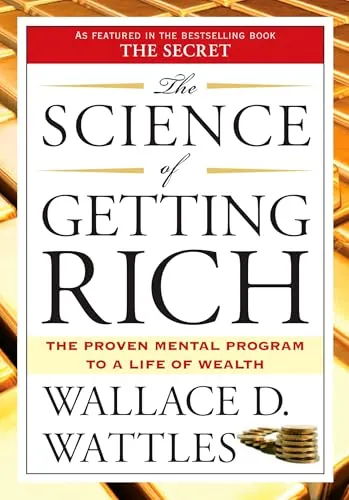
The Science of Getting Rich teaches that wealth is not random—it follows mental laws and disciplined action. Wallace D. Wattles offers a step-by- step method for attracting abundance by aligning thoughts, actions, and service to others. This book is a timeless guide for anyone who wants to build real wealth—not by chance, but by choice and consistency.
The Science of Getting Rich is a timeless classic that explores the mental and spiritual laws of wealth creation .
Written by Wallace D. Wattles , a leading figure in the New Thought movement , this book is one of the inspirations behind modern self-help and success literature—including The Secret and Think and Grow Rich .
Wattles presents a step-by-step mental science for creating wealth—not through luck or privilege, but through thought, action, and alignment with the principles of abundance .
“There is a thinking stuff from which all things are made.”
This summary walks you through the core principles of the book, showing how they can be applied to modern life, business, and personal growth.
Wattles challenges the idea that wealth is random or reserved for the lucky few.
He argues that:
“You can become rich by thought and action in harmony with the laws of wealth.”
This book is not about wishful thinking—it’s about applied mindset .
Wattles outlines a clear framework for getting rich, built on ten fundamental principles:
Rich people think with clarity and intention. They don’t let their minds wander into lack or fear.
“Thought must be directed by purpose.”
You must believe that wealth is possible—not just for others, but for you.
“Faith is the foundation of all achievement.”
Create a mental picture of the life you want. Your mind must believe in the possibility.
“The vision must be held constantly before you.”
Faith without action is dead. You must do the work, even when it’s not easy.
“You must move toward your vision daily.”
Wealth comes from adding value —not just taking. You must give more than you take.
“You must do more than a fair day’s work—you must do the best possible work.”
Fear, doubt, and jealousy block the flow of prosperity. You must guard your mind.
“Your thoughts shape your reality.”
Wattles introduces the idea of a Universal Mind —a field of creative intelligence that responds to your thoughts and actions.
“You are connected to the source of all wealth.”
Gratitude opens the door to more abundance. It shifts your focus from lack to sufficiency.
“Gratitude is the master key to wealth.”
Wealth is not a one-time event—it’s a habit. You must live like a wealthy person before you are one.
“Act as if you already have what you want—until you do.”
Persistence is non-negotiable. You must keep improving, keep serving, and keep moving forward.
“You will win if you never quit.”
Although over 100 years old, The Science of Getting Rich is still studied by entrepreneurs, influencers, and coaches because of its powerful message:
“Wealth is not about luck or birth—it’s about mindset and action.”
Wattles believed that:
This book is a blueprint for building wealth from the inside out.
Wattles introduces what would later be known as the Law of Attraction , but with a practical twist.
He teaches that:
“You do not attract what you want—you attract what you are.”
This idea is now echoed in books like The Secret , but Wattles adds a crucial element: you must work for what you want .
One of the most powerful lessons in the book is that wealth comes from service .
Wattles writes:
“No man can get rich serving himself.”
He explains that the rich are not rich because they are lucky—they are rich because they solve problems for others .
“You must give more in value than you receive in payment.”
This principle is still true today—whether you’re a freelancer, CEO, or content creator.
Key Insight: You don’t get rich by focusing on money—you get rich by focusing on value creation .
Wattles shows how to build a business that thrives:
He encourages entrepreneurs to:
“The successful person is not the one who knows the most—but the one who serves the most.”
This insight remains a cornerstone of modern business and personal branding.
Wattles’ principles extend beyond money. He teaches that:
“Riches of any kind begin in the mind.”
He encourages readers to treat all relationships with integrity and value , reinforcing that wealth is not just about money—but about life quality .
Though written in 1910, Wattles’ ideas influenced:
His teachings are still used by entrepreneurs, speakers, and creators who believe that wealth is a mindset —not a random event.
“The principles of wealth are timeless.”
Wattles dives into the psychology of success:
He emphasizes that your environment, your thoughts, and your actions must align with your goals.
“You cannot think one way and act another and expect success.”
Wattles offers practical tools you can use today:
Create a clear mental image of your desired life.
Write down what you’re thankful for daily—this opens your mind to abundance.
Repeat statements that align with wealth and success.
Take one step every day toward your goal—no matter how small.
Focus on what you give, not just what you get.
These emotions block abundance and damage relationships.
Wealth doesn’t come overnight—but it comes to those who keep going.
“You must do the things that rich people do—until you become one.”
Wattles encourages several mindset shifts that help readers move from lack to abundance:
These mental shifts help readers move from scarcity to abundance , from doubt to faith , and from inaction to execution .
The Science of Getting Rich is more than a book—it’s a blueprint for living with purpose, clarity, and abundance .
It teaches that:
As Wattles wrote:
“You are not here to be poor, any more than you are here to be sick. You are here to bring to the world the riches of all that you are.”